Bike laws and traffic laws for people on bikes, in cars, and people who walk in the state of California
I just finished a League of American Cyclists training course, and was really impressed with the depth of information covered in the course. One important aspect of the training is the law as it relates to how people share the roadways. This reflects traffic principles, bike laws, and infrastructure in their current state. I'm hoping there can continue to be improvements that will make it easier for people to walk and bike to get to where they need to go without the fear of being hit by a car. You shouldn't be required to drive a 5000 pound vehicle to pick up a loaf of bread and 12 eggs from a grocery store.
I'm still learning, and am definitely open to any corrections, different interpretations, and differences in different states. Feel free to let me know in the comments.
I am not a lawyer and remember that this does not constitute legal advice and is a general summary of research I've done so far. If you need a lawyer, here are some resources:
General principles
Traffic and bike laws are generally derived from a few general principles. These principles are also good to follow so that you can ride your bike safely to get where you need to go.
Your space on the road
Everybody is entitled to the space they occupy plus clearance to be able to move around safely
Ride with traffic, not against it
In the USA, traffic generally moves on the right side of the road. For someone on a bike, it means "ride as far right as practicable", where "practicable" is generally interpreted as "safe and reasonable". The law does not require that you ride so far to the right that you put yourself in unsafe situations!
This also means that someone on a bike should not ride against traffic. It's not safe because it gives everybody less reaction time, and it is unlawful. There is a small exception: Contraflow bicycle lanes. These are lanes where there is 2-way bicycle traffic and where a bike traffic lane may oppose a car traffic lane. Contraflow lanes usually have physical barriers between lanes to prevent head-on collisions.

Rules for right of way at intersections
There are places such as intersections and lane changes where some people on the road may need to yield in order to make sure everyone has a safe amount of space on the roadway.
Intersections are usually points where people sharing a road space will need to make decisions and follow procedures to prevent collisions. Road users should yield to cross traffic at intersections. Generally traffic from less busy roads yields to traffic on busier roads. For example, if someone is leaving a driveway, they would yield to traffic on the adjoining street. And traffic on a smaller residential street would yield to traffic on a larger arterial street according to this principle.
Controlled intersections
Controlled intersections have usually traffic signals or signs to indicate right of way. (Green means go, red means stop, etc!)
Uncontrolled intersections
At uncontrolled intersections, the rule is usually first come first served. This also applies if the intersection is a 4-way stop. If two people arrive at the same time, the rule might differ by state. In California, the person on the right goes first if two people arrive at the same time. (CVC 21800)
Rules for right of way for lane changes
People on the roadway need to yield when changing lanes. If you want to change lanes, you need to yield already in the lane that you want to enter.
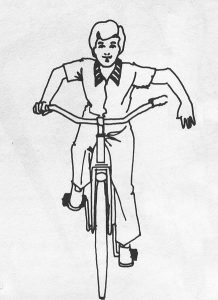
When on your bike, look, and then wait until you can find a gap. An easy way to remember this is:
SCAN, SIGNAL, THEN MERGE.
SCAN
Look over your shoulder to check for traffic beside you and behind you. Looking over your shoulder can also help signal your intent to those behind you.
SIGNAL
There are a few conventions for bike signaling. I find the easiest and most obvious to be to point in the direction you are going.
MERGE
Change lanes when you see a large enough gap to safely do so.
Slower traffic on the right
Your speed determines your general position on the road. Slower traffic usually moves to the right, and parked vehicles are usually farthest to the right. If you need to pass, the convention is to pass on the left side.
There are exceptions! If you are riding your bike in a marked bike lane, it is your right to pass slower moving traffic on the left.
Where do I ride in the lane?
You can choose your position within a lane so you can operate your bike safely. Bike laws in California state that you should ride your bike as far to the right as practicable. This does not mean that you need to yield space to cars. It is often not safe to ride as far to the right as you can. There is often debris and other hazards such as parked vehicles, poor roadway conditions, and so on. You may also end up in the "door zone", a spot where someone may open their car door when exiting a parked vehicle. Door zone collisions are usually bad and sometimes tragic. Note: A person in a car is legally obligated to not open their car door unless it is safe to do s.
Take the lane
If the road isn't wide enough for you to ride side by side with a car (it often isn't, unless the road is 14 feet wider or more) or if there is no bike lane, you can take the lane. When you're riding a bike, you still are legally entitled to your space on the road for operating your bike in a safe manner.
For such roads, you can take the lane. You can ride in the middle of the traffic lane to deter unsafe passing. You can position yourself in the lane so that a driver cannot pass you on the right or left while remaining in the same lane as you. The driver will need to change lanes in order to pass you.
This may sound a little scary, but it also helps make sure you are visible and predictable, and can prevent unsafe passing behavior from others on the road.
Obey traffic signs
This is kind of obvious, but everybody on the road needs to follow the rules posted on traffic signs in order to prevent collisions.
Laws as they relate to bikes in California
There are a subset of laws in California that relate specifically to people who ride bikes. Here are some of them.
Laws for people riding bikes in California
Helmet laws in California:
Helmets are required for those younger than 18 years of age. They are still recommended for everyone else. (CVC 21212)
Riding your bike on the sidewalk:
Riding your bike on the sidewalk is not recommended. Though cars don't normally drive along the sidewalk, there are still plenty of places where a cars can put you at risk if you are riding on the sidewalk. There are often many driveways that cross a sidewalk, and drivers aren't necessarily looking out for anyone riding a bicycle on the sidewalk. There are also other hazards (that make walking difficult too!) such as trash, recycling, and compost bins, signs, debris, and cars themselves.
There are no California state laws that prohibit riding on the sidewalk. But there are local bike laws that do. For example:
- In Oakland: Only <20” wheels and <14” frame permitted (OMC 10.16.150)
- In San Francisco: Children under age of 13 are permitted (SFTC 1007)
These codes have generally been written to only allow children to ride on the sidewalk.
Kyle from Paceline Law is a lawyer, and has written more about the subject of riding bicycles on the sidewalk.
Laws regarding bike lanes:
It turns out that in California, you are obligated to ride in the bike lane (CVC 21208). But there are some big exceptions:
- You can leave the bike lane if you are overtaking a slower or stopped vehicle
- You can leave the bike lane if you need to avoid debris or other hazards
- You will need to exit the bike lane if you are turning left or right
Headphone/earbud laws:
You are allowed to use headphones or earbuds when riding a bike in California. But you may not use headphones in both ears. (CVC 27400) This rule applies to drivers as well.
Laws regarding how you set up your bicycle:
Here are a few laws regarding how you set up your bike. Some are a little weird and obscure sounding, and others are exactly what you'd expect.
- Your bike must have functioning brakes (CVC 21201) - This one is interesting because it appears to indicate that a fixed gear bike without brakes is not technically street legal. If you have one brake, then you're probably fine though.
- Handlebars must be below your shoulders. Your seat must allow you to sit with one foot on ground (CVC 21201) - I assume the handlebar portion might be related to a specific type of bike? Being able to put one foot on the ground appears to be related to being able to stop your bicycle safely.
- Riding when dark: There are laws that require that you ride with lights on your bicycle.
- Headlight (visible from 300 feet)
- Rear reflector or light (visible from 500ft)
- Reflector on pedals, shoes or ankles (visible from 200ft) - This one surprised me. I think the idea is to make it easier to identify a person on a bike when it's dark because one can see pedals moving up and down.
-
Reflector on front wheel or front of bike (white or yellow) & rear wheel or rear of bike (white or red) or reflectorized tires (CVC 21201)
DUI:
DUI applies to bicycles too. (CVC 21200)
Laws for California drivers, as related to bikes
Driving in the bike lane:
Generally, it's a problem for any car to be in the bike lane. A lot of drivers misunderstand or don't care for their purpose and use bike lanes to park, get around traffic, or to check on their phones. This is not legal. However, drivers are allowed to and sometimes required to, by law at least, drive in the bike lane. Drivers are supposed to merge into the bike lane before making a right turn. This is supposed to be safer for everyone, as a driver would first need to yield to someone on a bike in the bike lane, then make the right turn. This can prevent right hook crashes, where a driver makes a right turn without yielding to bicycle through-traffic. (CVC 21209)
As a person on a bike, you can merge to the left out of the bike lane in order to pass a driver who is making a right turn from the bike lane.
3 foot law:
This is a new-ish law, passed in 2013. This law requires that drivers give at least 3 feet of clearance when passing someone on a bike. (CVC 21760). There are exceptions. If there aren't 3 feet available to pass, the driver must slow down and pass only when safe to do so.
Dooring laws:
When you're riding a bike, you have the right to ride in a safe position, and this includes not riding in the door zone.

Drivers are not to open their door unless it is safe to do so and does not interfere with moving traffic. It is also not lawful to leave the door open for an extended period of time (longer than necessary to load or unload passengers) (CVC 22517)
Laws for pedestrians
First off, a pedestrian isn't just someone who is walking on a sidewalk. A "pedestrian" according to state law may also include people on roller skates, skateboards, and mobility aids (tricycles, wheelchairs).
Pedestrians have the right of way in crosswalks
Pedestrians generally have the right of way in any crosswalk, marked or unmarked (for example, an intersection where there is a sidewalk or trail but no paint markings). The only exception to this rule is that pedestrians must yield to any immediate hazard before entering a crosswalk. The specific wording in California state law is, " No pedestrian may suddenly leave a curb or other place of safety and walk or run into the path of a vehicle that is so close as to constitute an immediate hazard" (CA 21950)
Weird bike laws
There are a few obscure bicycle laws out there, or maybe "laws" that have somehow entered urban legend status. I tried to verify all of these to see, and I couldn't do so with all of them.
No cycling with a slingshot in your pocket in Bellingham, WA
I could not verify this one. Any reference to this was an article listing weird bike or traffic laws.
No acrobatic or fancy riding in Galesburg, IL
This is real! There are laws in Galesburg against "Trick Riding". (Galesburg 73.15)
"No rider of a bicycle shall remove both hands from the handlebars, or feet from the pedals, or practice any acrobatic or fancy riding on any street. "
No riding over 65mph in Connecticut
This is true, but it doesn't look like a law specific to people who ride bikes. I think that generally no vehicle is permitted to travel faster than 65mph on the roadway.
No gargling mouthwash while cycling in Peridot, AZ
I could not verify this one either. Once again, all references I saw regarding this law were in compilations of weird laws.
No riding your bike hands-free in Colorado
You are not allowed to ride "without the handlebars" in Colorado, it's true. However, this is true in many other states as well.
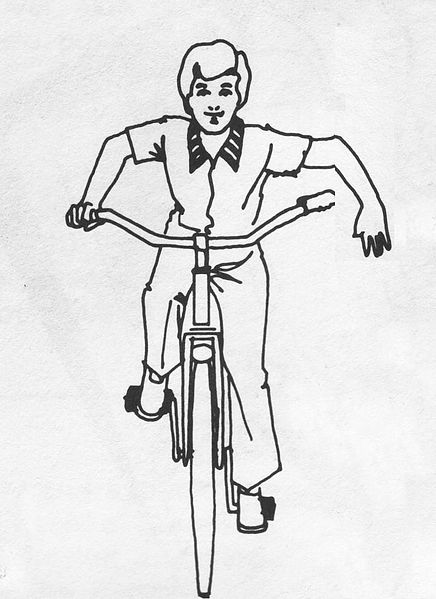


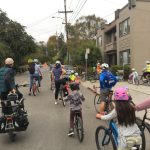
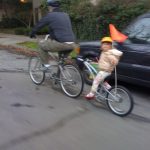
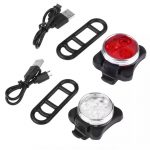
[…] are essential and are required according to state law. Basically, the headlight needs to […]